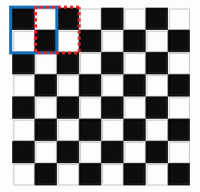By Ralph Connelly, Posted April 14, 2014 –
So,
how did things go in your classroom with the How Many Squares on a Checkerboard
task? I’m told that we’re still getting a good number of visits to the blog,
but few visitors are taking the next step and leaving a comment. The hope is
that the blog will become an interactive
way for members to share thoughts, comments, ideas, and so on. Please realize
that a comment need not be long—a simple “Tried it with my class—they really
liked it” is great. Maybe your students solved the task in a really interesting
way that you hadn’t thought of before; maybe you had to remove roadblocks before
students got going on the task. We would love to hear from you!
All
right, so let’s have a look at the How Many Squares on a Checkerboard task and
some approaches to solving it. A common strategy is to start with a
simpler problem:
How
many squares on a 1 × 1
square? 1
How
many squares on a 2 × 2
square? 5
(four 1 × 1 squares
and one 2 × 2 square)
How
many squares on a 3 × 3
square? 14
For this last one, solvers must see that the board has not only squares
of
different sizes but also overlapping squares, so a 3 × 3 square has 9
(nine) 1 × 1 squares; 4 different 2 × 2 squares (overlapping, as
demonstrated
in the checkerboard examples below; and 1 (one) 3 × 3 square),
and so on, until eventually arriving at the following solution:



How
many squares on an 8 × 8
checkerboard? 204
| 64 |
1 × 1 squares |
|
49 |
2 × 2 squares |
| 36 |
3 × 3 squares |
|
25 |
4 × 4 squares |
| 16 |
5 × 5 squares |
|
9 |
6 × 6 squares |
| 4 |
7 × 7 squares |
|
1 |
8 × 8 square |
Strategies
for identifying and extending patterns, drawing diagrams, making a table, and
so on soon come into play. Often the final result for the Checkerboard problem
is presented in a table like the one below.

Students
and teachers readily identify patterns that emerge. The problem can then be extended
to determine the total number of squares on any
size square board, with the corresponding algebra being introduced as
appropriate.
In
the higher grades, an extension might be to find the total number of rectangles
that can be found on an 8× 8 checkerboard.
(Warning: This is not at all trivial!)
So
what did you think of the Checkerboard task? How did your students respond to
the task? What strategies did they use? Did they encounter any stumbling blocks?
How did the student resolve the stumbling blocks? You are welcome to share
class photos or student work samples. Hope to hear from you!
 Ralph
Connelly is Professor Emeritus in the Faculty of Education at Brock
University in Ontario, where he taught elementary math methods courses
for 30+ years. He is active in both NCTM, where he’s served on several
committees, currently the Editorial Panel of TCM, and NCSM, where he’s
served two terms as Canadian Director as well as on numerous committees.
Ralph
Connelly is Professor Emeritus in the Faculty of Education at Brock
University in Ontario, where he taught elementary math methods courses
for 30+ years. He is active in both NCTM, where he’s served on several
committees, currently the Editorial Panel of TCM, and NCSM, where he’s
served two terms as Canadian Director as well as on numerous committees.
Archived Comments
This Student Math Notes activity is a great tool for exploring the checkerboard task.
http://www.nctm.org/publications/article.aspx?id=22347
Posted by: ElizabethS_05318 at 8/13/2014 10:49 AM